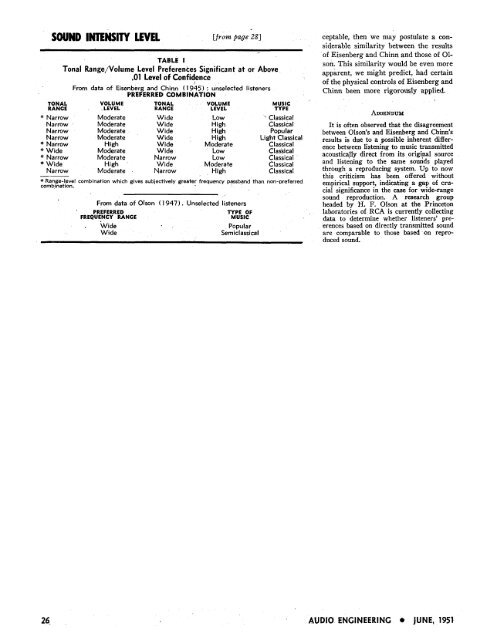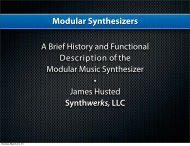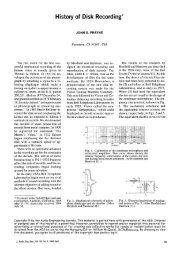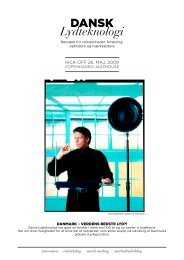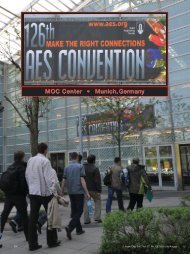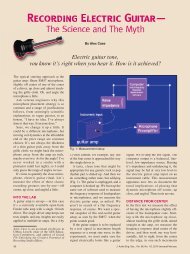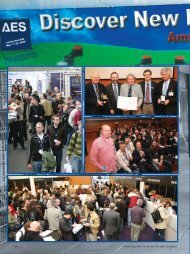Effect of Sound Intensity Level on Judgement of - Audio Engineering ...
Effect of Sound Intensity Level on Judgement of - Audio Engineering ...
Effect of Sound Intensity Level on Judgement of - Audio Engineering ...
Create successful ePaper yourself
Turn your PDF publications into a flip-book with our unique Google optimized e-Paper software.
SOUND INTENSITY LEVEL<br />
[from page 281<br />
TABLE I<br />
T<strong>on</strong>al Range/Volume <str<strong>on</strong>g>Level</str<strong>on</strong>g> Preferentes Significant at or Above<br />
-01 <str<strong>on</strong>g>Level</str<strong>on</strong>g> <str<strong>on</strong>g>of</str<strong>on</strong>g> C<strong>on</strong>fidence<br />
From data <str<strong>on</strong>g>of</str<strong>on</strong>g> Eisenberg and Chinn ( 1945) : unselected listeners<br />
PREFERRED COMBINATION<br />
TONAL VOLUME TONAL VOLUME MUSIC<br />
RANGE LEVEL RANGE LEVEL TYPE<br />
* Narrow Moderate Wide Low ' Classical<br />
Narrow Moderate Wide High Classical<br />
Narrow Moderate Wide HIgh Popular<br />
Narrow Moderate Wide H~gh Light Classical<br />
* Narrow High Wide Moderate Classical<br />
* Wide Moderate Wide Low Classical<br />
* Narrow Moderate Narrow Low Classical<br />
* Wide High Wide Moderate Classical<br />
Narrow<br />
-- Moderate Narrow High Classical<br />
* Range-level combinati<strong>on</strong> wh~ch gives subjectively greater frequency passband than n<strong>on</strong>-oreferred<br />
combinati<strong>on</strong>.<br />
From data <str<strong>on</strong>g>of</str<strong>on</strong>g> Ols<strong>on</strong> (1947). Unselected listeners<br />
' PREFERRED TYPE OF<br />
FREQUENCY RANGE MUSIC<br />
. Wide Popular<br />
Wide Semiclassical<br />
ceptable, then we may postulate a c<strong>on</strong>-<br />
siderable similarity between the results<br />
<str<strong>on</strong>g>of</str<strong>on</strong>g> Eisenberg and Chinn and those <str<strong>on</strong>g>of</str<strong>on</strong>g> 01-<br />
s<strong>on</strong>. This similarity would be even more<br />
apparent, we might predict, had certain<br />
<str<strong>on</strong>g>of</str<strong>on</strong>g> the physical c<strong>on</strong>trols <str<strong>on</strong>g>of</str<strong>on</strong>g> Eisenberg and<br />
Chinn been more rigorously applied.<br />
It is <str<strong>on</strong>g>of</str<strong>on</strong>g>ten observed that the disagreement<br />
between Ols<strong>on</strong>'s and Eisenberg and Chinn's<br />
results is due to a possible inherent differ-<br />
ence between listeniw to music transmitted<br />
acoustica!ly direct from its origi,nal source<br />
and listening to the same sounds played<br />
through a reproducing system. Up to now<br />
this criticism has been <str<strong>on</strong>g>of</str<strong>on</strong>g>fered without<br />
empirical support, indicating a gap <str<strong>on</strong>g>of</str<strong>on</strong>g> cru-<br />
cial significance in the case for wide-range<br />
sound reproducti<strong>on</strong>. A research group<br />
headed by H. F. Ols<strong>on</strong> at the Princet<strong>on</strong><br />
laboratories <str<strong>on</strong>g>of</str<strong>on</strong>g> RCA is currently collecting<br />
data to determine whether listeners' pre-<br />
erences based <strong>on</strong> directly transmitted sound<br />
are comparable to those based <strong>on</strong> repro-<br />
duced sound.<br />
AUDIO ENGINEERING * JUNE, 1951


